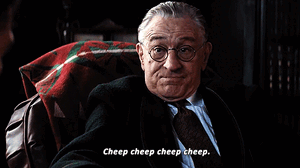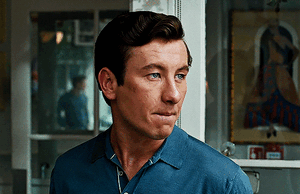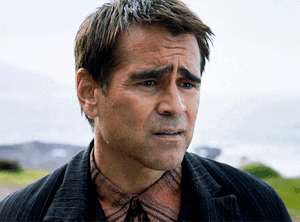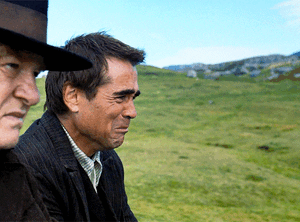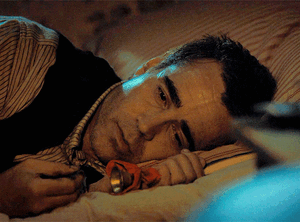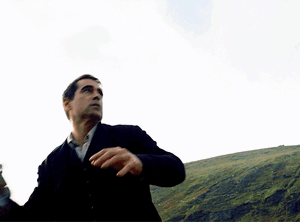
Everything posted by Jade Bahr
-
Leonardo DiCaprio - (Please Read First Post Prior to Posting)
@Sugarwater thx There are a LOT of first time oscar nominees this year I have to say. It's kinda nice. Also congrats to Marty for this record!
-
Emma Stone
Naaah this is Lilys season.
-
Lily Gladstone
- Leonardo DiCaprio - (Please Read First Post Prior to Posting)
There was a song in KOTFM? Is it the one when the osages dancing in circles in the very end?- Leonardo DiCaprio - (Please Read First Post Prior to Posting)
Weird. Claim: Paul Thomas Anderson Wrote ‘Killers of the Flower Moon’, NOT Eric Roth [Updated] UPDATED: I don’t want to name names here, but two sources of mine, one of which worked extensively on Scorsese’s film, are confirming Bramesco’s claim. There might, or might not, be a few trades reporting on this soon. If I was able to corroborate it then it’ll be very easy for them to do the same. Also, this was posted on the Hollywood Elsewhere comments section around nine months ago: EARLIER: A major claim is being made by The Guardian’s Charles Bramesco. He says that the “Killers of the Flower Moon” script was actually not written by Eric Roth, but rather by Paul Thomas Anderson! On X, a user pointed out that Roth had been snubbed of an adapted screenplay Oscar nomination this morning. It was indeed a surprise given that he was supposed to be a cinch to get nominated. Bramesco replied … The writer [Roth] hasn’t been on the circuit, because I heard pretty much the entire thing was rewritten by … PTA. We already know that there was a total script overhaul for ‘Killers.’ Scorsese and DiCaprio decided that, instead of depicting the point of view of the FBI, they were going to focus on the story of the Osage nation. It was thought that Roth had written both of these versions of the film, but Bramesco is implying that PTA came in and reportedly rewrote all of the script from scratch. That’s a bold move on his part, and, possibly, a tad unprofessional. It is odd, but not out of the ordinary, for a writer to get credited for a screenplay they didn’t write. However, Roth was being campaigned for Oscar consideration and has been nominated by other voting bodies. I’ve contacted Roth to comment on the story. I’ll be updating this one if anything else comes out in the next few hours ...- Leonardo DiCaprio - (Please Read First Post Prior to Posting)
I think it was the right decision to step back and putting Lily in the spotlight (I think she was great and carried the whole movie and I still wish the movie was all about her and I'll die on that hill). I don't think Leo's mad about the snub. He wanted Lily to get nominated obviously and that strategy succeeded. If she will win he will be over the moon (lol) I'm sure.- Leonardo DiCaprio - (Please Read First Post Prior to Posting)
💯- Leonardo DiCaprio - (Please Read First Post Prior to Posting)
DeNiro campaigned?- Last movie you saw...
One of my favorite franchises.- Leonardo DiCaprio - (Please Read First Post Prior to Posting)
Oscar Nominations 2024: The Final Predictions 2024 Oscar Predictions — Final Nominations Are Upon Us (UPDATED) 2024 Oscars Nomination Predictions For Every Category Oscar Futures: Our Final Predictions for the Nominees None of the biggies (awardsdaily, vulture, variety) are forgetting Leo but also don't really predicting him so yeah hope dies last right? 🤞- Leonardo DiCaprio - (Please Read First Post Prior to Posting)
Now it's only 3 hours - I'm nervous- Camila Morrone
- Jennifer Lopez
- Andrew Garfield
Agree 💯 and talented!!- Leonardo DiCaprio - (Please Read First Post Prior to Posting)
Not really Leo related but after Flower Moon it's now Summer Moon.- Andrew Garfield
- Matthew Bomer
- Margot Robbie
- Leonardo DiCaprio - (Please Read First Post Prior to Posting)
Oscars: ‘Killers of the Flower Moon’ and ‘Maestro’ stars aim for distinction 28 years in the making In the 95-year history of the Academy Awards, 88 films have each received nominations for both Best Actor and Best Actress. Although there have been 19 cases of two or more movies doing so in a single year, there hasn’t been such an occurrence since 1996, when both lead lineups included performers from “Dead Man Walking” and “Leaving Las Vegas.” However, according to Gold Derby’s late-stage 2024 Oscar nominations predictions, that nearly three-decade gap is set to soon be closed by costar pairs from “Killers of the Flower Moon” and “Maestro.” The vast majority of the Oscars prognosticators who’ve been shaping our odds all season agree that Leonardo DiCaprio and Lily Gladstone (“Killers of the Flower Moon”) and Bradley Cooper and Carey Mulligan (“Maestro”) will all clinch academy mentions for their lead performances. The last such quartet consisted of eventual winners Nicolas Cage (“Leaving Las Vegas”) and Susan Sarandon (“Dead Man Walking”) and their respective costars, Elisabeth Shue and Sean Penn. That was only the fourth time that a pair of similarly nominated films split the two trophies, following instances in 1940 (Robert Donat, “Goodbye, Mr. Chips” and Vivien Leigh, “Gone with the Wind”), 1952 (Humphrey Bogart, “The African Queen” and Leigh, “A Streetcar Named Desire”), and 1978 (Richard Dreyfuss, “The Goodbye Girl” and Diane Keaton, “Annie Hall”). In all, the 19 past sets of two or three nominees for both awards produced nine male and 10 female winners. The only two films that took both prizes were “Network” (1977, Peter Finch and Faye Dunaway) and “On Golden Pond” (1982, Henry Fonda and Katharine Hepburn), leaving “Rocky” and then both “Atlantic City” and “Reds” with neither. Those 1982 movies were the last trio to jointly pull off this nominations feat, following “The African Queen,” “A Place in the Sun,” and “A Streetcar Named Desire” in 1952 and “Bonnie and Clyde,” “The Graduate,” and “Guess Who’s Coming to Dinner” in 1968. There’s virtually no chance of that subset growing this year, unless “Past Lives” stars Teo Yoo and Greta Lee both miraculously land bids alongside the two expected duos. As of now, our odds indicate that the “Killers of the Flower Moon” and “Maestro” leads will ultimately be defeated in both categories by Cillian Murphy (“Oppenheimer”) and Emma Stone (“Poor Things”). From a historical standpoint, this would make sense given the fully failed attempts of six previous quartets, the last of whom starred in “The Remains of the Day” (Anthony Hopkins and Emma Thompson) and “What’s Love Got to Do with It” (Laurence Fishburne and Angela Bassett) and lost in 1994 to Tom Hanks (“Philadelphia”) and Holly Hunter (“The Piano”). Fortunately, the current hopefuls can take some comfort in the fact that, based on precedent, the most likely outcome of their situation would involve just one film winning one of the two awards. In this regard, Gladstone or Mulligan would follow Best Actress recipients Greer Garson (“Mrs. Miniver,” 1943), Grace Kelly (“The Country Girl,” 1955), Patricia Neal (“Hud,” 1964), and Hepburn (“Guess Who’s Coming to Dinner”), while Cooper or DiCaprio would emulate Lionel Barrymore (“A Free Soul,” 1931), James Stewart (“The Philadelphia Story,” 1941), and David Niven (“Separate Tables,” 1959). Thinking back over the last 27 years, there were many times when a case like this presumably almost happened, such as when DiCaprio’s 1998 snub for “Titanic” kept it from joining “As Good As It Gets” in both lineups and even when 2017 supporting victor Viola Davis (“Fences”) was initially running a lead campaign that might have put her film on the list alongside “La La Land.” Based on the strength of the current quartet this late in the game, one could argue that there’s never been a better opportunity for a 20th addition.- Leonardo DiCaprio - (Please Read First Post Prior to Posting)
He meant the movie should have been focused on the Osage instead the white dudes who already stole everything and now also the movie lol- Leonardo DiCaprio - (Please Read First Post Prior to Posting)
I think he perfectly managed the balance between spoiled snobbish kid (treating girls like they're exchangeable, getting bored quickly of people/friends, didn't know the name of the staff etc) but still being charming, kind and very likeable.- Leonardo DiCaprio - (Please Read First Post Prior to Posting)
- Leonardo DiCaprio - (Please Read First Post Prior to Posting)
So this whole Lily situation isn't me only remembering of last award season Colin Farrell (bless his heart) he's also delivering the exact moods after those disappointing bafta noms. No Leo No Lily No Marty Bye- Jenna Dewan
- Leonardo DiCaprio - (Please Read First Post Prior to Posting)
Account
Navigation
Search
Configure browser push notifications
Chrome (Android)
- Tap the lock icon next to the address bar.
- Tap Permissions → Notifications.
- Adjust your preference.
Chrome (Desktop)
- Click the padlock icon in the address bar.
- Select Site settings.
- Find Notifications and adjust your preference.
Safari (iOS 16.4+)
- Ensure the site is installed via Add to Home Screen.
- Open Settings App → Notifications.
- Find your app name and adjust your preference.
Safari (macOS)
- Go to Safari → Preferences.
- Click the Websites tab.
- Select Notifications in the sidebar.
- Find this website and adjust your preference.
Edge (Android)
- Tap the lock icon next to the address bar.
- Tap Permissions.
- Find Notifications and adjust your preference.
Edge (Desktop)
- Click the padlock icon in the address bar.
- Click Permissions for this site.
- Find Notifications and adjust your preference.
Firefox (Android)
- Go to Settings → Site permissions.
- Tap Notifications.
- Find this site in the list and adjust your preference.
Firefox (Desktop)
- Open Firefox Settings.
- Search for Notifications.
- Find this site in the list and adjust your preference.













